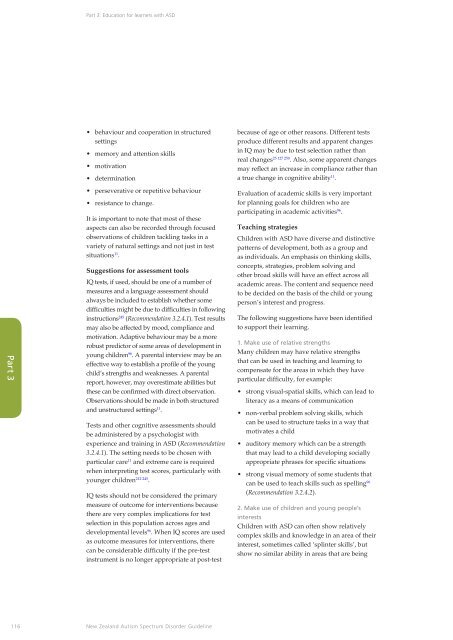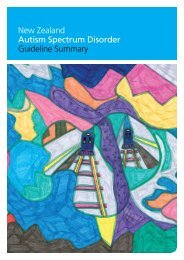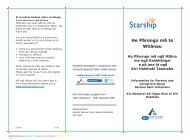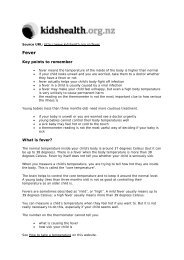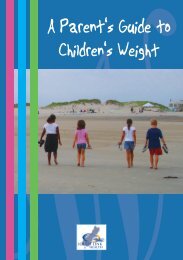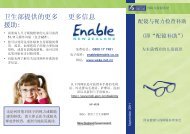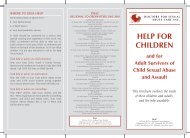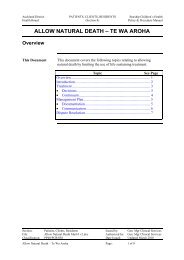New Zealand Autism Spectrum Disorder Guideline - Ministry of Health
New Zealand Autism Spectrum Disorder Guideline - Ministry of Health
New Zealand Autism Spectrum Disorder Guideline - Ministry of Health
You also want an ePaper? Increase the reach of your titles
YUMPU automatically turns print PDFs into web optimized ePapers that Google loves.
Part 3: Education for learners with ASD<br />
• behaviour and cooperation in structured<br />
settings<br />
• memory and attention skills<br />
• motivation<br />
• determination<br />
because <strong>of</strong> age or other reasons. Different tests<br />
produce different results and apparent changes<br />
in IQ may be due to test selection rather than<br />
real changes 25 127 250 . Also, some apparent changes<br />
may reflect an increase in compliance rather than<br />
a true change in cognitive ability 11 .<br />
Part 3<br />
• perseverative or repetitive behaviour<br />
• resistance to change.<br />
It is important to note that most <strong>of</strong> these<br />
aspects can also be recorded through focused<br />
observations <strong>of</strong> children tackling tasks in a<br />
variety <strong>of</strong> natural settings and not just in test<br />
situations 11 .<br />
Suggestions for assessment tools<br />
IQ tests, if used, should be one <strong>of</strong> a number <strong>of</strong><br />
measures and a language assessment should<br />
always be included to establish whether some<br />
difficulties might be due to difficulties in following<br />
instructions 245 (Recommendation 3.2.4.1). Test results<br />
may also be affected by mood, compliance and<br />
motivation. Adaptive behaviour may be a more<br />
robust predictor <strong>of</strong> some areas <strong>of</strong> development in<br />
young children 96 . A parental interview may be an<br />
effective way to establish a pr<strong>of</strong>ile <strong>of</strong> the young<br />
child’s strengths and weaknesses. A parental<br />
report, however, may overestimate abilities but<br />
these can be confirmed with direct observation.<br />
Observations should be made in both structured<br />
and unstructured settings 11 .<br />
Tests and other cognitive assessments should<br />
be administered by a psychologist with<br />
experience and training in ASD (Recommendation<br />
3.2.4.1). The setting needs to be chosen with<br />
particular care 11 and extreme care is required<br />
when interpreting test scores, particularly with<br />
younger children 212 245 .<br />
IQ tests should not be considered the primary<br />
measure <strong>of</strong> outcome for interventions because<br />
there are very complex implications for test<br />
selection in this population across ages and<br />
developmental levels 96 . When IQ scores are used<br />
as outcome measures for interventions, there<br />
can be considerable difficulty if the pre-test<br />
instrument is no longer appropriate at post-test<br />
Evaluation <strong>of</strong> academic skills is very important<br />
for planning goals for children who are<br />
participating in academic activities 96 .<br />
Teaching strategies<br />
Children with ASD have diverse and distinctive<br />
patterns <strong>of</strong> development, both as a group and<br />
as individuals. An emphasis on thinking skills,<br />
concepts, strategies, problem solving and<br />
other broad skills will have an effect across all<br />
academic areas. The content and sequence need<br />
to be decided on the basis <strong>of</strong> the child or young<br />
person’s interest and progress.<br />
The following suggestions have been identified<br />
to support their learning.<br />
1. Make use <strong>of</strong> relative strengths<br />
Many children may have relative strengths<br />
that can be used in teaching and learning to<br />
compensate for the areas in which they have<br />
particular difficulty, for example:<br />
• strong visual-spatial skills, which can lead to<br />
literacy as a means <strong>of</strong> communication<br />
• non-verbal problem solving skills, which<br />
can be used to structure tasks in a way that<br />
motivates a child<br />
• auditory memory which can be a strength<br />
that may lead to a child developing socially<br />
appropriate phrases for specific situations<br />
• strong visual memory <strong>of</strong> some students that<br />
can be used to teach skills such as spelling 96<br />
(Recommendation 3.2.4.2).<br />
2. Make use <strong>of</strong> children and young people’s<br />
interests<br />
Children with ASD can <strong>of</strong>ten show relatively<br />
complex skills and knowledge in an area <strong>of</strong> their<br />
interest, sometimes called ‘splinter skills’, but<br />
show no similar ability in areas that are being<br />
116<br />
<strong>New</strong> <strong>Zealand</strong> <strong>Autism</strong> <strong>Spectrum</strong> <strong>Disorder</strong> <strong>Guideline</strong>


